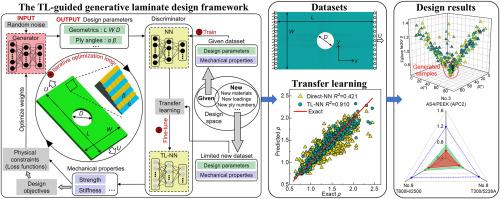数据有限的迁移学习导向生成层压板设计框架
IF 9.8
1区 材料科学
Q1 MATERIALS SCIENCE, COMPOSITES
引用次数: 0
摘要
纤维增强复合材料提供了巨大的定制潜力,但广泛的设计参数和探索新设计空间的需求对层压板设计构成了重大挑战。本文提出了一种迁移学习引导的生成层叠设计框架(TGLDF),以有效地扩展数据可用性有限的设计空间。TGLDF中的生成器通过数据缩放方法快速生成设计范围内的设计参数,以及基于神经网络的鉴别器,通过小数据集进行微调,以预测新设计空间内的机械性能。在本文中,为了使代能够达到设计目标,例如期望的强度和扭转刚度,引入了定制的代损失。通过两个实例验证了TGLDF在不同新设计空间下的有效性。这些例子包括单轴拉伸下的缺口层压板和耦合内压和轴向压缩下的复合管,涉及新材料、层数和加载条件。结果表明,在这些新的设计空间中,只需要少量的数据集就可以进行逆向设计。通过与有限元仿真和遗传算法(GAs)的对比分析,证明了TGLDF算法的有效性和优越性,该算法通过集成随机噪声来学习最优解的分布,优于遗传算法。此外,单热编码和连续参数的连接使TGLDF能够轻松扩展到其他设计场景。本文章由计算机程序翻译,如有差异,请以英文原文为准。

Transfer learning-guided generative laminate design framework with limited data availability
Fiber-reinforced composites offer significant tailoring potential, but extensive design parameters and the need to explore new design spaces pose substantial challenges in laminate designs. This paper presents a Transfer learning-guided Generative Laminate Design Framework (TGLDF) to efficiently extend design spaces with limited data availability. A generator in the TGLDF rapidly produces design parameters bounded within design ranges through a data scaling method, along with a neural network-based discriminator fine-tuned with small datasets to predict mechanical properties within new design spaces. Customized generation losses are incorporated to enable the generations to achieve design objectives, such as desired strength and torsional stiffness in this paper. Two examples were used to validate the TGLDF under different new design spaces. These examples include notched laminates under uniaxial tension and composite tubes subjected to coupled internal pressure and axial compression, involving new materials, ply numbers, and loading conditions. The results show that only small datasets are needed to perform inverse design in these new design spaces. A comparative analysis with finite element simulations and Genetic Algorithms (GAs) demonstrates the effectiveness and superiority of the TGLDF, which outperforms GAs by integrating random noise to learn the distribution of optimal solutions. In addition, the concatenating of one-hot encodings and continuous parameters enables the TGLDF to extend to other design scenarios easily.
求助全文
通过发布文献求助,成功后即可免费获取论文全文。
去求助
来源期刊

Composites Science and Technology
工程技术-材料科学:复合
CiteScore
16.20
自引率
9.90%
发文量
611
审稿时长
33 days
期刊介绍:
Composites Science and Technology publishes refereed original articles on the fundamental and applied science of engineering composites. The focus of this journal is on polymeric matrix composites with reinforcements/fillers ranging from nano- to macro-scale. CSTE encourages manuscripts reporting unique, innovative contributions to the physics, chemistry, materials science and applied mechanics aspects of advanced composites.
Besides traditional fiber reinforced composites, novel composites with significant potential for engineering applications are encouraged.
 求助内容:
求助内容: 应助结果提醒方式:
应助结果提醒方式:


